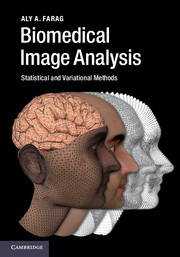Book contents
- Frontmatter
- Dedication
- Contents
- Preface
- Nomenclature
- 1 Overview of biomedical image analysis
- Part I Signals and systems, image formation, and image modality
- 2 Overview of two-dimensional signals and systems
- 3 Biomedical imaging modalities
- Part II Stochastic models
- Part III Computational geometry
- Part IV Variational approaches and level sets
- Part V Image analysis tools
- Index
- References
2 - Overview of two-dimensional signals and systems
from Part I - Signals and systems, image formation, and image modality
Published online by Cambridge University Press: 05 November 2014
- Frontmatter
- Dedication
- Contents
- Preface
- Nomenclature
- 1 Overview of biomedical image analysis
- Part I Signals and systems, image formation, and image modality
- 2 Overview of two-dimensional signals and systems
- 3 Biomedical imaging modalities
- Part II Stochastic models
- Part III Computational geometry
- Part IV Variational approaches and level sets
- Part V Image analysis tools
- Index
- References
Summary
Signals and systems approaches are based on fundamental theory and form the backbone of various disciplines in engineering and physics. Because of their importance, signals and systems are a well-established component of the engineering curriculum. In this chapter we review some of the basics of signals and systems as they pertain to image representation, processing, and analysis. Specifically, we study Fourier methods, which are fundamental to image reconstruction. We also study some systems methodologies of image processing and analysis. In all, the focus of the chapter is on the basics without plunging into the details of mathematical properties. For the expert reader, the chapter may act as a refresher and a quick overview of some of the well-known results of signals and systems. Otherwise, the intent of the chapter is to form a prelude to generalized model-based approaches of biomedical image analysis.
Definitions
A signal is a functional representation of a physical phenomenon captured by a sensor. That is, a signal may be defined as a transformation from a physical environment into a mathematical domain. The sensors are assumed to be capable of producing a meaningful description of the physical phenomenon. Signals theory deals, in the abstract sense, with the mathematical characterization of the functional forms of the signal, without regard to the phenomenon that generated it. In this chapter, however, we are interested in using the signal properties to infer information about the physical phenomenon. For example, if the signal is generated from an X-ray sensor directed at biological tissue, we are interested in a representation that describes the characteristics of the tissue. Similarly, in an MRI reconstruction application, we are most interested in signal representations that can describe the process of image formation from MRI. In short, we need to keep the physics of the problem in mind as we discuss signal theory.
Information
- Type
- Chapter
- Information
- Biomedical Image AnalysisStatistical and Variational Methods, pp. 9 - 38Publisher: Cambridge University PressPrint publication year: 2014
